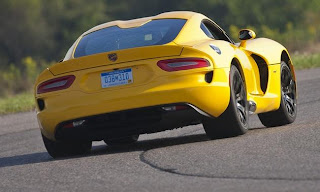
After a brief hiatus, the Viper V10 sports car returns as an SRT, not a Dodge, for the 2013 model year. There are major revisions across the board to boost performance and comfort, and a two-model lineup to broaden the Viper's appeal.
Let's start under the hood. The 8.4-liter V10 now uses a lighter, higher-flowing intake manifold made from composite material, replacing the previous cast aluminum unit. Other changes include forged pistons instead of cast pistons, lightweight sodium-filled exhaust valves, an aluminum flywheel and a single catalytic converter instead of dual units for better exhaust flow. All the engine changes deliver an additional 40 hp (to 640 hp) and 40 lb-ft of torque (to 600 lb-ft) over the previous Viper. And the 2013 engine weighs 25 pounds less.
The six-speed Tremec TR6060 manual transmission gets tighter spacing between the gear ratios, a shortened 3.55 final drive (from 3.07) and gear throws that are shorter by nearly 12.5 percent.
To help corral all that power the Viper gets standard traction control, multi-mode electronic stability control and launch control.
Like the engine, weight savings was the theme for the chassis. Chrysler engineers shaved more 100 pounds by using the newest high-strength steels for the space frame, carbon fiber for the hood, roof and rear hatch, aluminum body panels and lighter-weight wheels. The SRT Viper is also stiffer, with torsional rigidity up by 50 percent over the old car, helped in large part by the engine compartment X-brace lifted directly from the Viper GTS-R and Competition Coupe race cars. The increased rigidity improves the car's steering response.
Also helping to improve front end response is a wider, 62.4-inch track (up from 61.7 inches), and retuned Bilstein shocks, springs and hollow antiroll bars. Rear suspension geometry has been revised with the toe links relocated from behind the rear axle centerline to in front.
At the corners are Pirelli PZero tires--295/30 ZR-18 front and 355/30 ZR-19 rear-- with four-piston Brembo brakes providing the stopping muscle.
 The base SRT Viper uses fabric-covered Sabelt seats and skips the sound deadening material. The driver's seat is lowered by 0.8 inch for a better fit for taller drivers and drivers wearing safety helmets. The seat height can be adjusted by 1.6 inches. Seat travel has been increased by 3.5 inches and the center console is set lower for easier access to the shifter. In another Viper first, cruise control and push button start are standard.
The base SRT Viper uses fabric-covered Sabelt seats and skips the sound deadening material. The driver's seat is lowered by 0.8 inch for a better fit for taller drivers and drivers wearing safety helmets. The seat height can be adjusted by 1.6 inches. Seat travel has been increased by 3.5 inches and the center console is set lower for easier access to the shifter. In another Viper first, cruise control and push button start are standard.
The range-topping GTS model gets two-mode Bilstein Damptronic dampers with street and track settings--you can change modes with the push of a button on the center stack. A four-mode electronic stability control system adds speed sensors in each wheel and yaw, lateral-g and steering-wheel angle sensors. There's a sport mode that allows for significant lateral slip, a track mode that cuts out the traction control and allows even more lateral slip, and full-off mode that cuts all the electronic aids.
The GTS gets a sleeker, two-outlet hood and split six-spoke wheels instead of the SRT's five-spoke design. In the cabin, hand-stitched nappa leather covers the six-way power-adjustable seats, dash, center console, door panels and A-pillars. There's sound deadening material for a quieter ride and a 12-speaker Harman Kardon sound system. An optional premium interior package adds Laguna premium leather throughout the cabin and an Alcantara headliner.
Those looking for maximum performance will want to spring for the available track package, which adds two-piece StopTech slotted lightweight brake rotors, lighter wheels finished in black and Pirelli P Zero Corsa tires. The track package is offered on both the SRT and GTS models--it cuts 57 pounds from the car's curb weight.
No comments:
Post a Comment